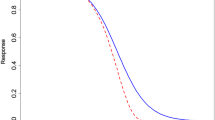Abstract
For mixtures of many chemicals, a ray design based on a relevant, fixed mixing ratio is useful for detecting departure from additivity. Methods for detecting departure involve modeling the response as a function of total dose along the ray. For mixtures with many components, the interaction may be dose dependent. Therefore, we have developed the use of a three-segment model containing both a dose threshold and an interaction threshold. Prior to the dose threshold, the response is that of background; between the dose threshold and the interaction threshold, an additive relationship exists; the model allows for departure from additivity beyond the interaction threshold. With such a model, we can conduct a hypothesis test of additivity, as well as a test for a region of additivity. The methods are illustrated with cytotoxicity data that arise when Chinese hamster ovary cells are exposed to a mixture of nine haloacetic acids.
Similar content being viewed by others
References
Berenbaum, M. C. (1981), “Criteria for Analyzing Interactions Between Biologically Active Agents,” Advances in Cancer Research, 35, 269–335.
Carpy, S. A., Kobel, W., and Doe, J. (2000), “Health Risk of Low-Dose Pesticides Mixtures: A Review of the 1985–1998 Literature on Combination Toxicology and Health Risk Assessment,” Journal of Toxicology and Environmental Health, Part B, 3, 1–25.
Casey, M., Gennings, C., Carter, W. H. Jr., Moser, V. C., and Simmons, J. E. (2004), “Detecting Interaction(s) and Assessing the Impact of Component Subsets in a Chemical Mixture Using Fixed-Ratio Mixture Ray Designs,” Journal of Agricultural, Biological, and Environmental Statistics, 9, 339–361.
Cox, C. (1987), “Threshold Dose-Response Models in Toxicology,” Biometrics, 43, 511–523.
Gennings, C., Carter, W. H. Jr., Campain, J. A., Bae, D., and Yang, R. S. H. (2002), “Statistical Analysis of Interactive Cytotoxicity in Human Epidermal Keratinocytes Following Exposure to a Mixture of Four Metals,” Journal of Agricultural, Biological and Environmental Statistics, 7, 58–73.
Gennings, C., Carter, W. H. Jr., Carchman, R. A., DeVito, M. J., Simmons, J. E., and Crofton, K. M. (2007), “The Impact of Exposure to a Mixture of Eighteen Polyhalogenated Aromatic Hydrocarbons on Thyroid Function: Estimation of an Interaction Threshold,” Journal of Agricultural, Biological and Environmental Statistics, 12, 96–111.
Gennings, C., Schwartz, P., Carter, W. H. Jr., and Simmons, J. E. (1997), “Detection of Departures from Additivity in Mixtures of Many Chemicals with a Threshold Model,” Journal of Agricultural, Biological, and Environmental Statistics, 2, 198–211.
Hamm, A. K. (2004), “Analysis of an Interaction Threshold in Drug/Chemical Mixtures,” unpublished Ph.D. Dissertation, Virginia Commonwealth University Department of Biostatistics, Richmond, VA.
McCullagh, P. (1983), “Quasi-Likelihood Functions,” The Annals of Statistics, 11, 59–67.
McCullagh, P., and Nelder, J. A. (1989), Generalized Linear Models (2nd ed.), New York: Chapman & Hall.
Plewa, M. J., Kargalioglu, Y., Vankerk, D., Minear, R. A., and Wagner, E. D. (2000), “Development of Quantitative Comparative Cytotoxicity and Genotoxicity Assays for Environmental Hazardous Chemicals,” Water Science and Technology, 42, 109–116.
— (2002), “Mammalian Cell Cytotoxicity and Genotoxicity Analysis of Drinking Water Disinfection By-products,” Environmental and Molecular Mutagenesis, 40, 134–142.
Plewa, M. J., Wagner, E. D., Jazwierska, P., Richardson, S. D., Chen, P. H., and McKague, A. B. (2004), “Chemical Characterization, Mammalian Cell Cytotoxicity and Genotoxicity of Halonitromethane Drinking Water Disinfection By-Products,” Environmental Science and Technology, 38, 62–68.
Richardson, S. D., Simmons, J. E., and Rice, G. (2002), “Disinfection Byproducts: The Next Generation,” Environmental Science and Technology, 36 (9), 198A–205A.
Schwartz, P. F., Gennings, C., and Chinchilli, V. M. (1995), “Threshold Models for Combination Data From Reproductive and Developmental Experiments,” Journal of the American Statistical Association, 90, 862–870.
Seber, G. A. F., and Wild, C. J. (2003), Nonlinear Regression, New York: Wiley.
Stork, L. G., Gennings, C., Carter, W. H. Jr., Johnson, R. E., Mays, D. P., Simmons, J. E., Wagner, E. D., and Plewa, M. J. (2007), “Testing for Additivity in Chemical Mixtures Using a Fixed-Ratio Ray Design and Statistical Equivalence Testing Methods,” Journal of Agricultural, Biological, and Environmental Statistics, 12, 514–533.
Ulm, K. (1991), “A Statistical Method for Assessing a Threshold in Epidemiological Studies,” Statistics in Medicine, 10, 341–349.
U.S. Environmental Protection Agency (2000), “Supplementary Guidance for Conducting Health Risk Assessment of Chemical Mixtures”. USEPA EPA/630/R-00/002. National Center for Environmental Assessment, Office of Research and Development, Washington, D.C. 51 FR 34014. Available: http://www.epa.gov/NCEA/raf/chem_mix.htm.
Author information
Authors and Affiliations
Corresponding author
Additional information
Disclaimer: The research described in this article has been reviewed by the National Health and Environmental Effects Research Laboratory, Office of Research and Development, U.S. Environmental Protection Agency and approved for publication. Approval does not signify that the contents necessarily reflect the views and policies of the Agency nor does mention of trade names or commercial products constitute endorsement or recommendation for use.
Rights and permissions
About this article
Cite this article
Yeatts, S.D., Gennings, C., Wagner, E.D. et al. Detecting Departure From Additivity Along a Fixed-Ratio Mixture Ray With a Piecewise Model for Dose and Interaction Thresholds. JABES 15, 510–522 (2010). https://doi.org/10.1007/s13253-010-0030-x
Accepted:
Published:
Issue Date:
DOI: https://doi.org/10.1007/s13253-010-0030-x




